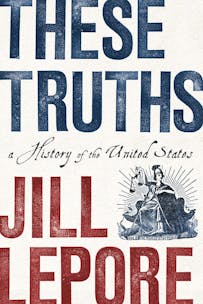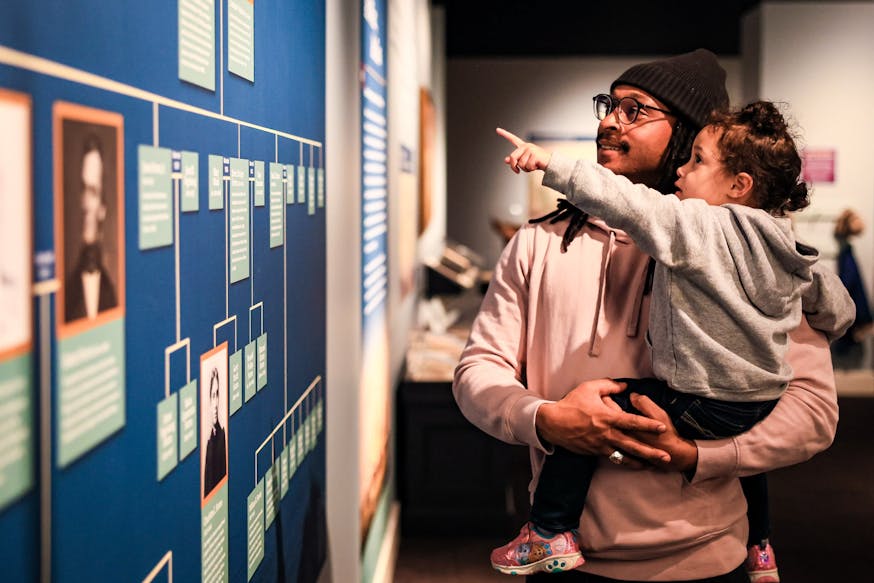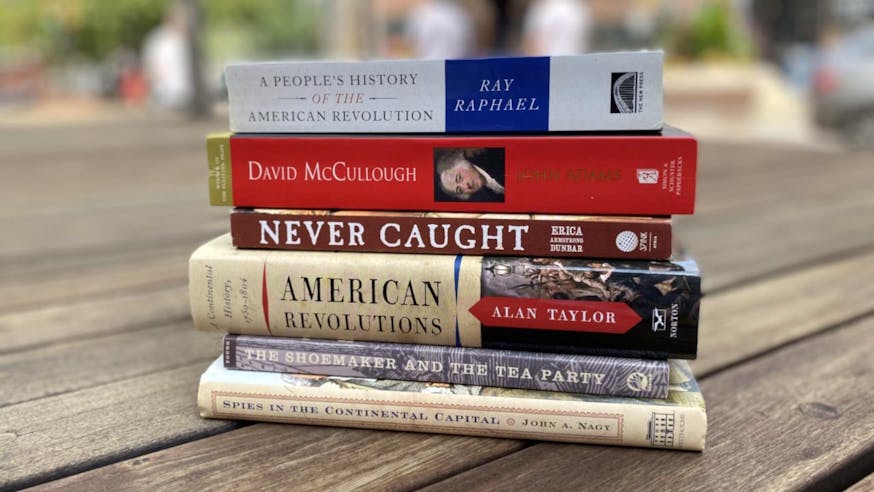Read the Revolution
These Truths
June 28, 2023
Political equality, natural rights, and the sovereignty of the people. “These truths,” as Thomas Jefferson called them, embody the core message of the Declaration of Independence. They are “sacred & undeniable,” as described in a 1776 draft of the nation’s founding document.
But has the nation, and democracy itself, delivered on that promise?
That’s the question – the thesis – at the heart of historian Jill Lepore’s ambitious book, These Truths: A History of the United States. Deemed a “sweeping, sobering account of the American past” by New York Times Book Review, Lepore begins her expansive analysis in 1492 and takes readers through more than five centuries from the nation’s origins to its rise and its divides. Throughout These Truths, Lepore wrestles with the state of American politics, the legacy of slavery, the persistence of inequality, and the nature of technological change. As Lepore writes, “A nation born in contradiction… will fight, forever, over the meaning of its history.”
In this excerpt from the introduction of These Truths, Lepore sets the stage for her exploration of the contradictions, the promises of “these truths,” and an exhaustive account of American history.
Excerpt
THE AMERICAN EXPERIMENT rests on three political ideas – “these truths,” Thomas Jefferson called them – political equality, natural rights, and the sovereignty of the people. “We hold these truths to be sacred & undeniable,” Jefferson wrote in 1776, in a draft of the Declaration of Independence:
that all men are created equal & independent, that from that equal creation they derive rights inherent & inalienable, among which are the preservation of life, & liberty, & the pursuit of happiness; that to secure these ends, governments are instituted among men, deriving their just powers from the consent of the governed.
The roots of these ideas are as ancient as Aristotle and as old as Genesis and their branches spread as wide as the limbs of an oak. But they are this nation’s founding principles: it was by declaring them that they nation came to be. In the centuries since, these principles have been cherished, decried, and contested, fought for, fought over, and fought against. After Benjamin Franklin read Jefferson’s draft, he picked up his quill, scratched out the words “sacred & undeniable,” suggested that “these truths” were, instead, “self-evident.” This was more than a quibble. Truths that are sacred and undeniable are God-given and divine, the stuff of religion. Truths that are self-evident are laws of nature, empirical and observable, the stuff of science. This divide has nearly rent the Republic apart.
Still, this divide is nearly always overstated and it’s easy to exaggerate the difference between Jefferson and Franklin, which in those lines, came down, too, to style: Franklin’s revision is more forceful. The real dispute isn’t between Jefferson and Franklin, each attempting, in his way, to reconcile faith and reason, as many have tried both before and since. The real dispute is between “these truths” and the course of events: Does American history prove these truths, or does it belie them?
Before the experiment began, the men who wrote the Declaration of Independence and the Constitution made an extraordinary careful study of history. They’d been studying history all their lives. Benjamin Franklin was eighty-one years old, hunched and crooked, when he signed the Constitution in 1787, with his gnarled and speckled hand. In 1731, when he was twenty-five, straight as a sapling, he’d written an essay called “Observations on Reading History,” on a “little Paper, accidentally preserv’d.” And he’d kept on reading history, and taking notes, asking himself, year after year: What does the past teach?
Sign Up!
Get biweekly Read the Revolution featured excerpts right to your inbox.
The United States rests on a dedication to equality, which is chiefly a moral idea, rooted in Christianity, but it rests, too on a dedication to inquiry, fearless and unflinching. Its founders agreed with the Scottish philosopher and historian David Hume, who wrote, in 1748, that “Records of Wars, Intrigues, Factions, and Revolutions are so many Collections of Experiments.” They believed that truth is to be found in ideas about morality but also in the study of history.
It has often been said, in the twenty-first century and in earlier centuries, too, that Americans lack a shared past and that, built on a cracked foundation, the Republic is crumbling, Part of this argument has to do with ancestry: Americans are descended from conquerors and from the conquered, from people held as slaves and from people who held them, from the Union and from the Confederacy, from Protestants and from Jews, from Muslims and from Catholics, and from immigrants and from people who have fought to end immigration. Sometimes, in American history – in nearly all national histories – one person’s villain is another’s hero. But part of this argument has to do with ideology: the United States is founded on a set of ideas, but Americans have become so divided that they no longer agree, if they ever did, about what those ideas are, or were.
I wrote this book because writing an American history from beginning to end and across that divide hasn’t been attempted in a long time, and it’s important, and it seemed worth a try. One reason it’s important is that understanding history as a form of inquiry – not as something easy or comforting but as something demanding and exhausting – was central to the nation’s founding. This, too, was new. In the West, the oldest stories, the Iliad and the Odyssey, are odes and tales of wars and kings, of men and gods, sung and told. These stories were memorials, and so were the histories of antiquity: they were meant as monuments. “I have written my work, not as an essay which is to win the applause of the moment,” Thucydides wrote, “but as a possession for all time.” Herodotus believed that the purpose of writing history was “so that time does not erase what man has brought into being.” A new kind of historical writing, less memorial and more unsettling, only first emerged in the fourteenth century. “History is a philosophical science,” the North African Muslim scholar Ibn Khaldun wrote in 1377, in the prologue to his history of the world, in which he defined history as the study “of the causes and origins of existing things.”
Only by fits and starts did history become not merely a form of memory but also a form of investigation, to be disputed, like philosophy, its premises question, its evidence examined, its arguments countered. Early in the seventeenth century, Sir Walter Ralegh began writing his own History of the World, from a prison in the Tower of London where he was allowed to keep a library of five hundred books. The past, Ralegh explained, “hath made us acquainted with our dead ancestors,” but it also casts light on the present, “by the comparison and application of other men’s fore-passed miseries with our own like errors and ill deservings.” To study the past is to unlock the prison of the present.
This new understanding of the past attempted to divide history from faith. The books of world religious – the Hebrew Bible, the New Testament, and the Quran – are pregnant with mysteries, truths known only by God, taken on faith. In the new history books, historians aimed to solve mysteries and to discover their own truths. The turn from reverence to inquiry, from mystery to history, was crucial to the founding of the United States. It didn’t require abdicating faith in the truths of revealed religion and it relieved no one of the obligation to judge right from wrong. But it did require subjecting the past to skepticism, to look to beginnings not to justify ends, but to question them – with evidence.
“I offer nothing more than simple facts, plain arguments, and common sense,” Thomas Paine, the spitfire son of an English grocer, wrote in Common Sense, in 1776. Kings have no right to reign, Paine argued, because if we could trace hereditary monarchy back to its beginnings – “could we take off the dark covering of antiquity, and trace them to their first rise” – we’d find “the first of them nothing better than the principal ruffian of some restless gang.” James Madison explained Americans’ historical skepticism, this deep empiricism, this was: “Is it not the glory of the people of America, that, whilst they have paid a decent regard to the opinions of former times and other nations, they have not suffered a blind veneration for antiquity, for custom, or for names, to overrule the suggestions of their own good sense, the knowledge of their own situation, and the lessons of their own experience?” Evidence, for Madison, was everything.
“A new era for politics is struck,” Paine write, his pen aflame, and “a new method of thinking hath arisen.” Declaring independence was itself an argument about the relationship between the present and the past, an argument that required evidence of a very particular kind: historical evidence. That’s why most of the Declaration of Independence is a list of historical claims. “To prove this,” Jefferson wrote, “let facts be submitted to the candid world.”
Facts, knowledge, experience, proof. These words come from the law. Around the seventeenth century, they moved into what was then called “natural history”: astronomy, physics, chemistry, geology. By the eighteenth century they were applied to history and to politics, too. These truths: this was the language of reason, of enlightenment, of inquiry, and of history. In 1787, then, when Alexander Hamilton asked “whether societies of men are really capable or not of establishing food government from reflection and choice, or whether they are forever destined to depend for their political constitutions on accident and force,” that was the kind of question a scientist asks before beginning an experiment. Time alone would tell. But time has passed. The beginning has come to an end. What, then, is the verdict of history?
Jill Lepore, These Truths: A History of the United States (W.W. Norton, 2018).
Tags
Learn More

A Revolutionary Summer

Black Founders: The Forten Family of Philadelphia
February 11 - November 26, 2023